 I am happy to announce my upcoming opening of Objective Subjects at the TePaske Art Gallery at Northwestern College in Orange City Iowa. The work includes many pieces that were first shown in my MFA exhibition at the University of North Dakota. The show will also have a number of new pieces. I am thankful for NWC's hosting of this work, their work to publicize the show and the opening. Below is their press release. NORTHWESTERN ART EXHIBIT TO FEATURE 8-13-12 WORK BY NORTH DAKOTA ARTIST RYAN STANDER FOR IMMEDIATE RELEASE ORANGE CITY, Iowa—“Objective Subjects,” an exhibit by North Dakota artist Ryan Stander, will be on display in the Te Paske Gallery of Northwestern College Aug. 21 through Sept. 14, with a public reception scheduled for Friday, Aug. 24, at 7 p.m. Stander’s show reflects his interests in memory and vernacular photography and explores the relationship between the archivist and the objects in an archive. Traditionally viewed as an objective repository of items and information essential to human history, archives now are understood to reflect the cultural and historical biases of the curator—or as Stander puts it, “the inescapable fingerprint of archivist in the formation of the archive, human memory and, ultimately, history itself.” As part of his exploration of objectivity and subjectivity in the interpretation of texts and objects, Stander has taken thousands of vintage snapshot photographs, most purchased through eBay, and placed them in traditional archive and museum trays and drawers to suggest the modern scientific approach. By modifying them with translucent layers and white-on-white lithograph backgrounds, however, he also suggests the cultural framework— including beliefs, biases and assumptions—that guide human interpretations. Originally from northwest Iowa, Stander now lives in Grand Forks, N.D., where he earned a Master of Fine Arts degree in mixed media from the University of North Dakota. He also holds a master’s degree in theology from Sioux Falls Seminary and a bachelor’s degree in art from Northwestern College. His work has been exhibited internationally in China, South Africa, Nicaragua and Grenada, and nationally in New York, New Jersey, Missouri, Kentucky and Texas. More extensive exhibitions across the upper Midwest have included North and South Dakota, Montana, Minnesota, Iowa and Wisconsin. Northwestern’s Te Paske Gallery is located in the Thea G. Korver Visual Arts Center, on Highway 10 at 214 8th Street SW in Orange City. Gallery hours are 8 a.m. to midnight Monday through Saturday and 1 p.m. to midnight Sunday. by Anita Cirulis
0 Comments
 Take a look at this article and images. I am not sure how I feel about this. This photo is one of a number of religious statues remade into the forms of superheroes. I look at this with mixed emotions of humor and enjoyment, and then I turn and feel as if someone has stolen and defaced our sacred symbols. This fickleness in my heart and mind comes from my dual vocation as an artist and theologian. I appreciate the wit, I appreciate the humor. I appreciate the conceptual aspects. But there is something within me that still bothers me. But again I am suprised by the some of the thoughtful comments on the page drawing the ties between superheroes and religious figures. This causes me to ask, where do we draw the line in what is blasphemous? I recently picked up Brent Plate's Blasphemy: Art that Offends. Like most of my amazing book collection, I have not had time to pick it up and work through it. But I hope that when I do, it will help me work through these ideas in an articulate way.  A couple of weeks ago I posted on a photo I picked up over Easter of a mother holding a child still during a photo. I metnioned how this forms a motif in vintage studio photography of the hidden mother. I bumped into a great site this morning that has a good number of example the "Invisible Mother" as they call it. I suppose I understand the practice considering the sqirmy or frightened child, but why cover the head of the mother? Why not photograph the two together or instead draw upon a Madonna and Child sort of precedent? Some of the photos in this motif do hide the mother quite well, others...well...do not. Because they are so obvious, they look rediculous...and kinda creepy. Anyway...Enjoy. Occasionally I see some good postings off of Facebook....this happens to be one of them. If you are a photographer, you would do well to check this out.
The Photography Tips that 96 Photographers Wish They Would've Learned Sooner. Enjoy  One of my all-time favorite movies is Empire Records. The film depicts the efforts of several high school teens fighting to keep their beloved record store and jobs while the owner sells out to the “man.” Anyway, one of my favorite lines in this favorite movie comes from the character AJ when in trouble with the manager says, “Who knows where thoughts come from? They just appear.” AJ’s comments describe a feeling often associated with the creative impulse and the difficulty in defining the creative process. Sometimes ideas just appear…or seem like they do. Sometimes I am simply amazed at the human mind and its creative ability. So perhaps it is ironic that I am working on a conference paper on the source of the creative idea when this realization comes around again. Yesterday I was at an impasse on my paper. I was stuck and could not figure out how to order and transition between various pieces of the paper. By midday I had largely put the impasse out of mind with the intent of returning when I was mentally ready to tackle the issue. I went to bed like normal. But I awoke (was I asleep or someplace in between?) and knew how to make order the disparate pieces of the paper. How does that happen? This is not the first time this has happened either. There are nights when I have wrestled in a fitful sleep with words and ideas all night…over and over I turn the problem. I awake with little rest and no solutions. And yet, in seminary when working day and night on my thesis, it happened several times when I was stuck on a transition point that the words and sentences came. But where do these ideas and solutions come from? What is it about sleep or the relaxation of the brain into dreaming, that allows for the creative mind to keep working? I’m not sure…but I am thankful when it does.  In my ongoing effort to migrate from my old blog AOA, I am continuing in a series of reposts. One of my favorite books on photography is Geoffry Batchen's Each Wild Idea. The book contains 9 essays wrestling with the histories of photography. My favorite chapter, not surprisingly, is on vernacular photography. Batchen's work attempts to elucidate the "complex matter of photography's conceptual, historical, and physical identity." He continues, "Morphology is another of those issues that most histories of photography ignore. Indeed, the invisibility of the photograph, its transparency to its referent, has long been one of its most cherished features. Most of us tend to look at photographs as if we are simply gazing through a two-dimensional window onto some outside world. This is almost a perceptual necessity; in order to see what the photograph is of, we must first repress our consciousness of what the photograph is. As a consequence, in even the most sophisticated discussions, the photograph itself--the actual thing being examined--is usually left out of the analysis. Vernacular photographies tend to go the other way, so frequently do they exploit the fact that the photograph is something that can also have volume, opacity, tactility, and a physical presence in the world. In many cases, the exploitation involves the the subject of the photograph's intervening within or across the photographic act. These subjects make us attend to their photography's morphologies, and thus to look right at rather than only through the photograph. In this sense, vernacular photo objects can be read not only as sensual and creative artifacts but also as thoughtful, even provocative meditations on the nature of photography itself" (Pages 59-60). One of the trajectories of my MFA show was a means to highlight is the physical nature of the photograph. Batchen's text was released in 2001, and since then the digital revolution has only picked up speed further minimizing the physicality of photographic objects. The vernacular photographic objects that I have collected over the past few years intend to highlight the diversity from this relatively young medium. Varying in sizes and processes, the objects mounted in artifact trays, encapsulated in drawers, bins etc intend to suggest the physicality of the photo object. It has been interesting to me in this process the varying sizes, papers, and processes that were quickly cast away as the technology of photography advanced. Fewer and fewer sizes of film and prints were available over time to where we are now, if we print our images at all, have the options of 3.5x5, 4x6, 5x7 etc. Some of my favorite photos that I have collected are the smallest ones that are 2x3ish. 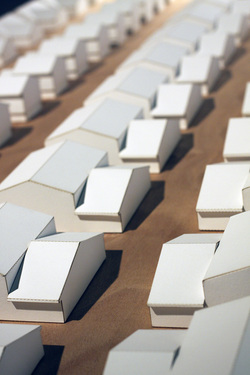 As I said a few weeks ago, it is MFA season here at UND's Hughes Fine Art Center. Last week Meghan Duda presented her work. Influenced by a range of artists from the New Topographics to Gordon Matta-Clark, Meghan's work considers the ubiquity of the suburban home. When Meghan and her husband relocated to Fargo a few years ago, she was struck by the possibility of horizontal expansion has shaped the suburban housing areas of Fargo. Home shapes follow a few rough patterns in theses new developments. And yet Fargo is not alone in that respect. Several of her images come from Utah as well. As someone who shares her interest in the New Topographics, I was immediately struck by (at least what appears to me) a strong lineage with several members of the group, namely Stephen Shore and the Becher's. Her connection to Shore is in subject matter while her connection to the Becher's is in matter of typologies of suburban homes as well as their rigorous system of grids within their installations. Following this method of Becher's typologies, Duda has laser cut the houses from the image thus breaking up the picture plane. By floating the image off the back frame, she is able to accentuate the break and absence with the lighting and shadows. On others, she has used the laser to etch detailed house floor plans over the image. Another one of the key factors in her images is that she also draws upon the objective or sense of detachment so often associated with the group but extends backward strongly to Ed Ruscha. Like the New Topographers, she attempts to stay neutral...balancing between critique and endorsement.  Last week was the first of UND's MFA final exhibitions. First up was Patrick Awotwe. Patrick's African influences are unmistakable in his beautiful work. He blends traditional symbols and imagery into both his metals and fiber works. I have included a variety of images from the show, including his artist statement. Enjoy.  Last week was a great week in spite of the all the different things going on. Thursday I drove out to Minot and Minot State University for my opening of Concrete Abstractions (a collection of 24 photos of regional architecture). During the opening I gave a short artist talk about the work and my interests in photography. The next morning, I gave a lecture on the art historical influences of the body of work that ranged from Edward Hopper, Charles Sheeler to Ed Ruscha, and of course, the New Topographics. It was a great to visit and mingle with students, meet faculty and generally see the work hanging. Much of the work has never been shown before so it is nice to have it see the light of day. Saturday was unexpected. A friend offered us free to tickets to see Sir Elton John. While I am not a huge fan, I wasn’t gonna pass up the opportunity to see a legend…especially for free. He put on a great show that we followed up with a trip to Rhombus with friends. And now its back to getting ready for my show at the Empire Art Center here in Grand Forks. Another solo show. Sometimes I wonder why I do this to myself. Sure it looks great on the CV, it doesn’t feel the best amidst the craziness. The Empire show goes up next Monday and will be a series of 21 small prints from the Visual Analogues series. This collection of prints is largely all new (2011-2012) and has yet to be shown anywhere. We are still contemplating an opening or closing reception…details to follow. This week also marks a busy month of MFA grad shows at the Hughes Fine Art Center. This week is Patrick Awotwe from Ghana. His metals and tapestries are remarkable. If you are in the Grand Forks area, please get over to UND to see the show.  Sometimes getting new art is better than making art. This is a piece we (Sundog Multiples) made last spring for Barton Benes. Ive been waiting to get this one framed and hung for 6 months and finally got it finished today. This is one of Barton's new pieces that integrates stamps into a weaving of sorts like prayer rug. |
Ryan StanderArchives
January 2018
Categories
All
|
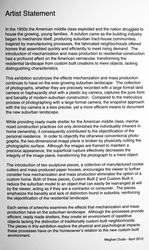











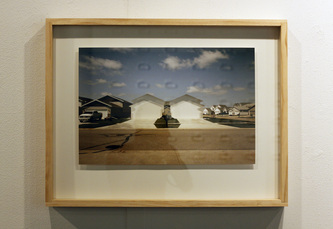

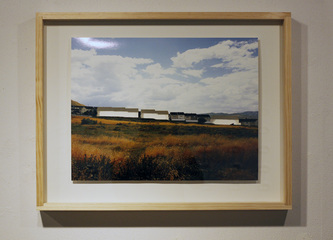



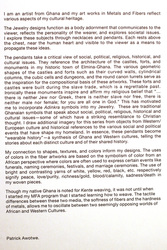
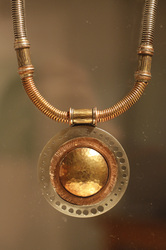
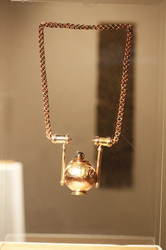
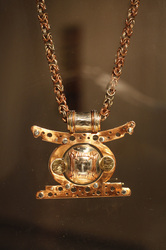
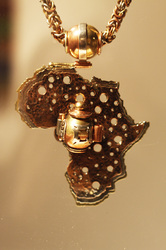
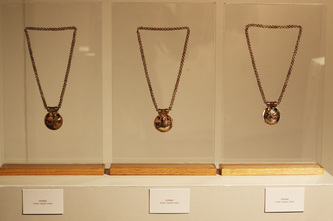

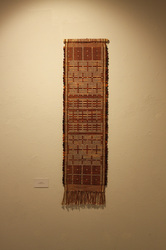

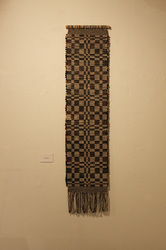
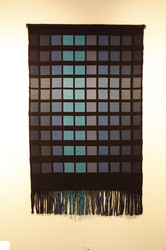


 RSS Feed
RSS Feed
